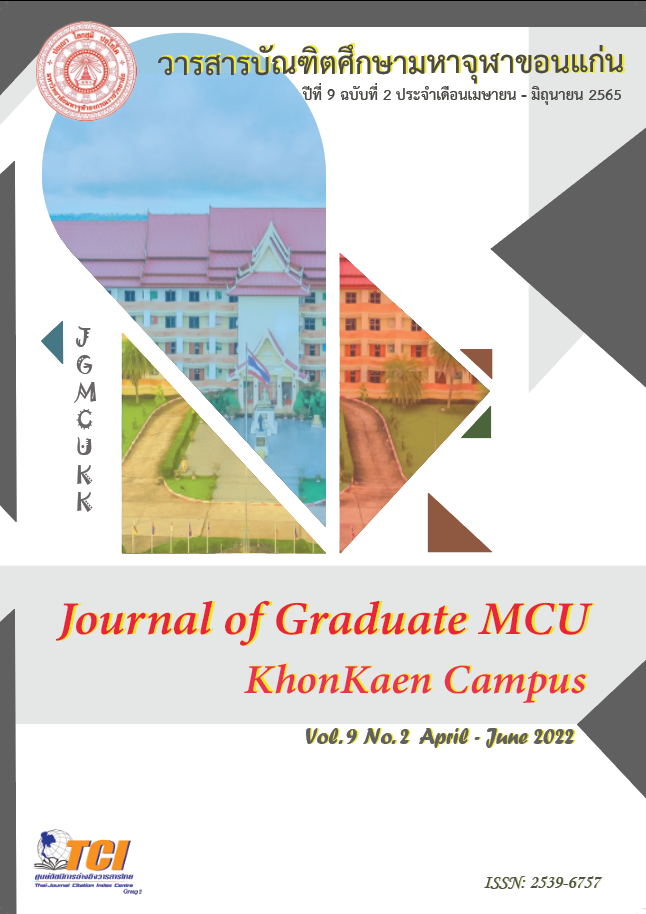The Cultural of Pu-Cha Drums of Thai-Yong in Baan Don-Luang, Mae Rang Sub-District, Pa Sang District, Lamphun Province The Cultural of Pu-Cha Drums of Thai-Yong in Baan Don-Luang, Mae Rang Sub-District, Pa Sang District, Lamphun Province
Main Article Content
Abstract
The objectives of the research on the cultural of Pu-Cha drums of the Thai Yong people at Baan Don Luang, Mae Rang Sub-district, Pa Sang District, Lamphun Province, were as follows: (1) To study the musical characteristics of Pu-Cha drums, Baan Don Luang, Mae Rang Sub-district, Pa Sang District, Lamphun Province. (2) To study the
relationship of Pu-Cha drums to the culture of the Thai-Yong community in Baan Don Luang, as well as other relevant community cultures. The methodological approach used in this research was qualitative; data was collected through both structured and unstructured interviews. The study found that the Pu-Cha drums of Thai-Yong in Baan Don Luang are an ancient musical culture that is the legacy of generations, and the treasure of the community. The instruments accompanying with Phu-Cha drums are several types of Lanna instruments, such as Pu-Cha drums, Ta lod pode drum, Nae, cymbals, and gong. When mixing the band, the role and function of each instrument is assigned, Phu-Cha drums play as the leading instrument while the accompanying musical instruments are gongs, cymbals, and Ta lod pode drums. The rhythm of Pu-cha drumming includes the melody of Seur Kop Tu, Sao Lap Ter melody, Lhong Nan melody, and Fad Sae melody, and the melody of the Tung Nong drum has been added to the present. There are 9 musicians in Pu-Cha drums band, who are members of the Baan Don Luang community and villagers in nearby communities. Pu-Cha drums in Baan Don Luang
represent beliefs and rituals. In addition to that, Pu-Cha drums play a role in cultural society in various areas, including the role of communication within the community, respect for Buddhist monks, and the role of preserving the local cultures of other communities.
Article Details

This work is licensed under a Creative Commons Attribution-NonCommercial-NoDerivatives 4.0 International License.
References
เชียงใหม่นิวส์. (2560). “แต่งสี อวดลาย ผ้าฝ้ายดอนหลวง” งานหัตถกรรมผ้าฝ้าย อำเภอป่าซาง จังหวัดลำพูน. สืบค้นเมื่อ 7 มีนาคม 2565, จาก https://www.chiangmainews.co.th/page/archives/584095/
ณัฐพงศ์ ปันดอนตอง. (2564). กลองปู่จาในประวัติศาสตร์ล้านนา พิธีกรรม ความเชื่อในภูมิภาคลุ่มน้ำโขง. วารสารวิชาการมนุษยศาสตร์และสังคมศาสตร์ มหาวิทยาลัยราชภัฏอุตรดิตถ์, 8(1), 15-28.
ธนพงศ์ เด็ดแก้ว. (2557). กลองปู่จาในวัฒนธรรมไทยลื้อ ตำบลหย่วน อำเภอเชียงคำ จังหวัดพะเยา. (วิทยานิพนธ์ศิลปศาสตรมหาบัณฑิต). พิษณุโลก: มหาวิทยาลัยนเรศวร.
ปิยมาศ มาวงศ์. (2561). ไตยอง ประวัติศาสตร์เอกลักษณ์อาหารที่ยาวนานของบ้านดอนหลวง. วารสารมังรายสาร, 6(2), 27-35.
พรสวรรค์ จันทะวงศ์. (2558). กลองบูชาในสังคมและวัฒนธรรมของชาวเชียงใหม่. วารสารวิจัยราชภัฏเชียงใหม่, 16(2), 17-28.
พระธนาเทพ สกฺกวํโส. (2560). ศึกษาการอนุรักษ์ก๋องปู่จาของชาวพุทธ ในเขตอำเภอเมือง จังหวัดลำปาง. (วิทยานิพนธ์พระพุทธศาสนามหาบัณฑิต). เชียงใหม่: มหาวิทยาลัยมหาจุฬาลงกรณราชวิทยาลัย.
พิพัฒน์พงศ์ มาศิริ. (2559). การเปลี่ยนแปลงอัตลักษณ์ของดนตรีล้านนา. (วิทยานิพนธ์ปรัชญาดุษฎีบัณฑิต). เชียงราย: มหาวิทยาลัยแม่ฟ้าหลวง.
เพ็ญสุภา สุขคตะ. (2562). ทำไมคนยองเมืองลำพูน จึงไม่เรียกตัวเองว่า “ไทลื้อ”. สืบค้นเมื่อ 12 ตุลาคม 2564, จาก https://www.matichonweekly.com/column/article _257167
ยศ สันตสมบัติ. (2544). มนุษย์กับวัฒนธรรม. (พิมพ์ครั้งที่ 3). กรุงเทพฯ: มหาวิทยาลัย ธรรมศาสตร์.
รัตนะ ตาแปง. (2563). การส่งเสริมศิลปะการแสดงกลองปู่จาของชุมชนรอบกว๊านพะเยาอย่างมีส่วนร่วม. วารสารวิจัยเพื่อการพัฒนาเชิงพื้นที่, 12(1), 77-86.
วรวุฒิ สุภาพ. (2546). กระบวนการถ่ายทอดวัฒนธรรมกลองปู่จา กรณีศึกษาจังหวัดลำปาง. (วิทยานิพนธ์ครุศาสตรมหาบัณฑิต). กรุงเทพฯ: จุฬาลงกรณ์มหาวิทยาลัย.
วันชัยยุทธ วงษ์เทพ. (2558). ศิลปะกลองชัยมงคลภูมิปัญญาล้านนา สู่การออกแบบตกแต่งภายในศูนย์ศิลปะการแสดง. วารสารวิชาการคณะสถาปัตยกรรมศาสตร์ มหาวิทยาลัยขอนแก่น, 14(2), 61-73.
ศิริ อเนอกสิทธิสิน และ ภัทระ คมขำ. (2560). กรรมวิธีการสร้างกลองปู่จาของครูญาณสองเมืองแก่น. วารสารศิลปกรรมศาสตร์ จุฬาลงกรณ์มหาวิทยาลัย, 3(2), 118-131.
อาทิตย์ วงศ์สว่าง. (2557). การอนุรักษ์และฟื้นฟูการตีกลองปู่จาล้านนาของกลุ่มลายคำในจังหวัดเชียงใหม่. (วิทยานิพนธ์ศิลปศาสตรมหาบัณฑิต). เชียงใหม่: มหาวิทยาลัยเชียงใหม่.

